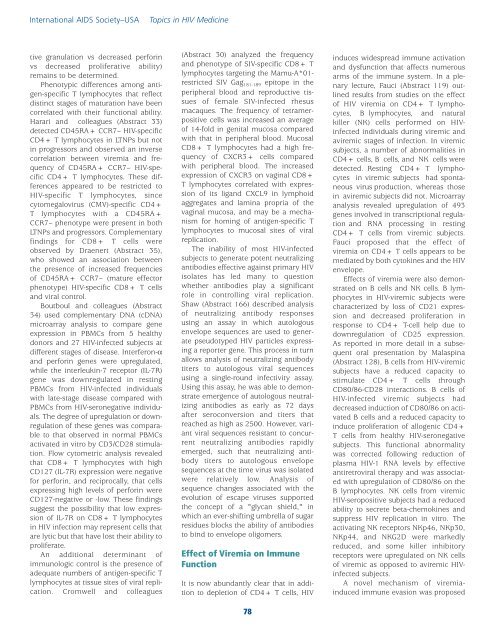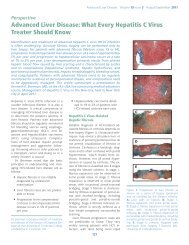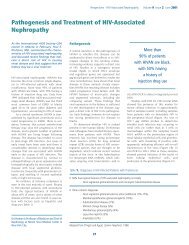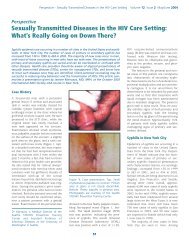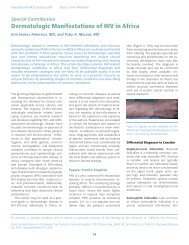Topics in HIV Medicine® - International AIDS Society-USA
Topics in HIV Medicine® - International AIDS Society-USA
Topics in HIV Medicine® - International AIDS Society-USA
You also want an ePaper? Increase the reach of your titles
YUMPU automatically turns print PDFs into web optimized ePapers that Google loves.
<strong>International</strong> <strong>AIDS</strong> <strong>Society</strong>–<strong>USA</strong><br />
<strong>Topics</strong> <strong>in</strong> <strong>HIV</strong> Medic<strong>in</strong>e<br />
tive granulation vs decreased perfor<strong>in</strong><br />
vs decreased proliferative ability)<br />
rema<strong>in</strong>s to be determ<strong>in</strong>ed.<br />
Phenotypic differences among antigen-specific<br />
T lymphocytes that reflect<br />
dist<strong>in</strong>ct stages of maturation have been<br />
correlated with their functional ability.<br />
Harari and colleagues (Abstract 33)<br />
detected CD45RA+ CCR7– <strong>HIV</strong>-specific<br />
CD4+ T lymphocytes <strong>in</strong> LTNPs but not<br />
<strong>in</strong> progressors and observed an <strong>in</strong>verse<br />
correlation between viremia and frequency<br />
of CD45RA+ CCR7– <strong>HIV</strong>-specific<br />
CD4+ T lymphocytes. These differences<br />
appeared to be restricted to<br />
<strong>HIV</strong>-specific T lymphocytes, s<strong>in</strong>ce<br />
cytomegalovirus (CMV)-specific CD4+<br />
T lymphocytes with a CD45RA+<br />
CCR7– phenotype were present <strong>in</strong> both<br />
LTNPs and progressors. Complementary<br />
f<strong>in</strong>d<strong>in</strong>gs for CD8+ T cells were<br />
observed by Draenert (Abstract 35),<br />
who showed an association between<br />
the presence of <strong>in</strong>creased frequencies<br />
of CD45RA+ CCR7– (mature effector<br />
phenotype) <strong>HIV</strong>-specific CD8+ T cells<br />
and viral control.<br />
Boutboul and colleagues (Abstract<br />
34) used complementary DNA (cDNA)<br />
microarray analysis to compare gene<br />
expression <strong>in</strong> PBMCs from 5 healthy<br />
donors and 27 <strong>HIV</strong>-<strong>in</strong>fected subjects at<br />
different stages of disease. Interferon-α<br />
and perfor<strong>in</strong> genes were upregulated,<br />
while the <strong>in</strong>terleuk<strong>in</strong>-7 receptor (IL-7R)<br />
gene was downregulated <strong>in</strong> rest<strong>in</strong>g<br />
PBMCs from <strong>HIV</strong>-<strong>in</strong>fected <strong>in</strong>dividuals<br />
with late-stage disease compared with<br />
PBMCs from <strong>HIV</strong>-seronegative <strong>in</strong>dividuals.<br />
The degree of upregulation or downregulation<br />
of these genes was comparable<br />
to that observed <strong>in</strong> normal PBMCs<br />
activated <strong>in</strong> vitro by CD3/CD28 stimulation.<br />
Flow cytometric analysis revealed<br />
that CD8+ T lymphocytes with high<br />
CD127 (IL-7R) expression were negative<br />
for perfor<strong>in</strong>, and reciprocally, that cells<br />
express<strong>in</strong>g high levels of perfor<strong>in</strong> were<br />
CD127-negative or -low. These f<strong>in</strong>d<strong>in</strong>gs<br />
suggest the possibility that low expression<br />
of IL-7R on CD8+ T lymphocytes<br />
<strong>in</strong> <strong>HIV</strong> <strong>in</strong>fection may represent cells that<br />
are lytic but that have lost their ability to<br />
proliferate.<br />
An additional determ<strong>in</strong>ant of<br />
immunologic control is the presence of<br />
adequate numbers of antigen-specific T<br />
lymphocytes at tissue sites of viral replication.<br />
Cromwell and colleagues<br />
(Abstract 30) analyzed the frequency<br />
and phenotype of SIV-specific CD8+ T<br />
lymphocytes target<strong>in</strong>g the Mamu-A*01-<br />
restricted SIV Gag 181-189 epitope <strong>in</strong> the<br />
peripheral blood and reproductive tissues<br />
of female SIV-<strong>in</strong>fected rhesus<br />
macaques. The frequency of tetramerpositive<br />
cells was <strong>in</strong>creased an average<br />
of 14-fold <strong>in</strong> genital mucosa compared<br />
with that <strong>in</strong> peripheral blood. Mucosal<br />
CD8+ T lymphocytes had a high frequency<br />
of CXCR3+ cells compared<br />
with peripheral blood. The <strong>in</strong>creased<br />
expression of CXCR3 on vag<strong>in</strong>al CD8+<br />
T lymphocytes correlated with expression<br />
of its ligand CXCL9 <strong>in</strong> lymphoid<br />
aggregates and lam<strong>in</strong>a propria of the<br />
vag<strong>in</strong>al mucosa, and may be a mechanism<br />
for hom<strong>in</strong>g of antigen-specific T<br />
lymphocytes to mucosal sites of viral<br />
replication.<br />
The <strong>in</strong>ability of most <strong>HIV</strong>-<strong>in</strong>fected<br />
subjects to generate potent neutraliz<strong>in</strong>g<br />
antibodies effective aga<strong>in</strong>st primary <strong>HIV</strong><br />
isolates has led many to question<br />
whether antibodies play a significant<br />
role <strong>in</strong> controll<strong>in</strong>g viral replication.<br />
Shaw (Abstract 166) described analysis<br />
of neutraliz<strong>in</strong>g antibody responses<br />
us<strong>in</strong>g an assay <strong>in</strong> which autologous<br />
envelope sequences are used to generate<br />
pseudotyped <strong>HIV</strong> particles express<strong>in</strong>g<br />
a reporter gene. This process <strong>in</strong> turn<br />
allows analysis of neutraliz<strong>in</strong>g antibody<br />
titers to autologous viral sequences<br />
us<strong>in</strong>g a s<strong>in</strong>gle-round <strong>in</strong>fectivity assay.<br />
Us<strong>in</strong>g this assay, he was able to demonstrate<br />
emergence of autologous neutraliz<strong>in</strong>g<br />
antibodies as early as 72 days<br />
after seroconversion and titers that<br />
reached as high as 2500. However, variant<br />
viral sequences resistant to concurrent<br />
neutraliz<strong>in</strong>g antibodies rapidly<br />
emerged, such that neutraliz<strong>in</strong>g antibody<br />
titers to autologous envelope<br />
sequences at the time virus was isolated<br />
were relatively low. Analysis of<br />
sequence changes associated with the<br />
evolution of escape viruses supported<br />
the concept of a "glycan shield," <strong>in</strong><br />
which an ever-shift<strong>in</strong>g umbrella of sugar<br />
residues blocks the ability of antibodies<br />
to b<strong>in</strong>d to envelope oligomers.<br />
Effect of Viremia on Immune<br />
Function<br />
It is now abundantly clear that <strong>in</strong> addition<br />
to depletion of CD4+ T cells, <strong>HIV</strong><br />
78<br />
<strong>in</strong>duces widespread immune activation<br />
and dysfunction that affects numerous<br />
arms of the immune system. In a plenary<br />
lecture, Fauci (Abstract 119) outl<strong>in</strong>ed<br />
results from studies on the effect<br />
of <strong>HIV</strong> viremia on CD4+ T lymphocytes,<br />
B lymphocytes, and natural<br />
killer (NK) cells performed on <strong>HIV</strong><strong>in</strong>fected<br />
<strong>in</strong>dividuals dur<strong>in</strong>g viremic and<br />
aviremic stages of <strong>in</strong>fection. In viremic<br />
subjects, a number of abnormalities <strong>in</strong><br />
CD4+ cells, B cells, and NK cells were<br />
detected. Rest<strong>in</strong>g CD4+ T lymphocytes<br />
<strong>in</strong> viremic subjects had spontaneous<br />
virus production, whereas those<br />
<strong>in</strong> aviremic subjects did not. Microarray<br />
analysis revealed upregulation of 493<br />
genes <strong>in</strong>volved <strong>in</strong> transcriptional regulation<br />
and RNA process<strong>in</strong>g <strong>in</strong> rest<strong>in</strong>g<br />
CD4+ T cells from viremic subjects.<br />
Fauci proposed that the effect of<br />
viremia on CD4+ T cells appears to be<br />
mediated by both cytok<strong>in</strong>es and the <strong>HIV</strong><br />
envelope.<br />
Effects of viremia were also demonstrated<br />
on B cells and NK cells. B lymphocytes<br />
<strong>in</strong> <strong>HIV</strong>-viremic subjects were<br />
characterized by loss of CD21 expression<br />
and decreased proliferation <strong>in</strong><br />
response to CD4+ T-cell help due to<br />
downregulation of CD25 expression.<br />
As reported <strong>in</strong> more detail <strong>in</strong> a subsequent<br />
oral presentation by Malasp<strong>in</strong>a<br />
(Abstract 128), B cells from <strong>HIV</strong>-viremic<br />
subjects have a reduced capacity to<br />
stimulate CD4+ T cells through<br />
CD80/86-CD28 <strong>in</strong>teractions. B cells of<br />
<strong>HIV</strong>-<strong>in</strong>fected viremic subjects had<br />
decreased <strong>in</strong>duction of CD80/86 on activated<br />
B cells and a reduced capacity to<br />
<strong>in</strong>duce proliferation of allogenic CD4+<br />
T cells from healthy <strong>HIV</strong>-seronegative<br />
subjects. This functional abnormality<br />
was corrected follow<strong>in</strong>g reduction of<br />
plasma <strong>HIV</strong>-1 RNA levels by effective<br />
antiretroviral therapy and was associated<br />
with upregulation of CD80/86 on the<br />
B lymphocytes. NK cells from viremic<br />
<strong>HIV</strong>-seropositive subjects had a reduced<br />
ability to secrete beta-chemok<strong>in</strong>es and<br />
suppress <strong>HIV</strong> replication <strong>in</strong> vitro. The<br />
activat<strong>in</strong>g NK receptors NKp46, NKp30,<br />
NKp44, and NKG2D were markedly<br />
reduced, and some killer <strong>in</strong>hibitory<br />
receptors were upregulated on NK cells<br />
of viremic as opposed to aviremic <strong>HIV</strong><strong>in</strong>fected<br />
subjects.<br />
A novel mechanism of viremia<strong>in</strong>duced<br />
immune evasion was proposed


